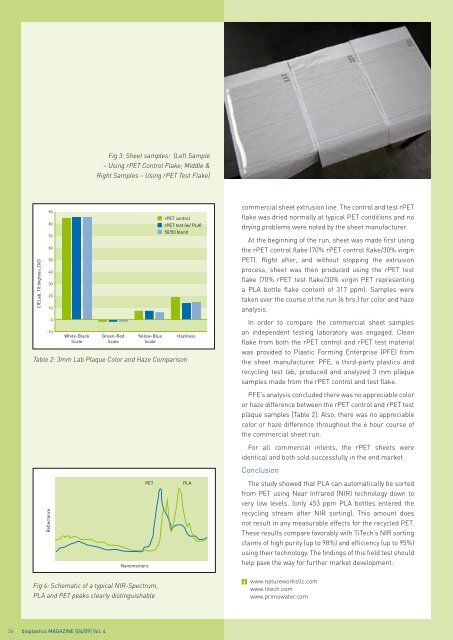bioplasticsMAGAZINE_0904
bioplasticsMAGAZINE_0904
bioplasticsMAGAZINE_0904
You also want an ePaper? Increase the reach of your titles
YUMPU automatically turns print PDFs into web optimized ePapers that Google loves.
Fig 3: Sheet samples: (Left Sample<br />
– Using rPET Control Flake; Middle &<br />
Right Samples – Using rPET Test Flake)<br />
CIELab, 10 degrees, D65<br />
90<br />
80<br />
70<br />
60<br />
50<br />
40<br />
30<br />
20<br />
10<br />
rPET control<br />
rPET test (w/ PLA)<br />
50/50 blend<br />
commercial sheet extrusion line. The control and test rPET<br />
flake was dried normally at typical PET conditions and no<br />
drying problems were noted by the sheet manufacturer.<br />
At the beginning of the run, sheet was made first using<br />
the rPET control flake (70% rPET control flake/30% virgin<br />
PET). Right after, and without stopping the extrusion<br />
process, sheet was then produced using the rPET test<br />
flake (70% rPET test flake/30% virgin PET representing<br />
a PLA bottle flake content of 317 ppm). Samples were<br />
taken over the course of the run (6 hrs.) for color and haze<br />
analysis.<br />
0<br />
-10<br />
White-Black<br />
Scale<br />
Green-Red<br />
Scale<br />
Yellow-Blue<br />
Scale<br />
Haziness<br />
Table 2: 3mm Lab Plaque Color and Haze Comparison<br />
In order to compare the commercial sheet samples<br />
an independent testing laboratory was engaged. Clean<br />
flake from both the rPET control and rPET test material<br />
was provided to Plastic Forming Enterprise (PFE) from<br />
the sheet manufacturer. PFE, a third-party plastics and<br />
recycling test lab, produced and analyzed 3 mm plaque<br />
samples made from the rPET control and test flake.<br />
PFE’s analysis concluded there was no appreciable color<br />
or haze difference between the rPET control and rPET test<br />
plaque samples [Table 2]. Also, there was no appreciable<br />
color or haze difference throughout the 6 hour course of<br />
the commercial sheet run.<br />
For all commercial intents, the rPET sheets were<br />
identical and both sold successfully in the end market.<br />
Conclusion<br />
Reflectance<br />
Nanomenters<br />
PET<br />
PLA<br />
The study showed that PLA can automatically be sorted<br />
from PET using Near Infrared (NIR) technology down to<br />
very low levels. (only 453 ppm PLA bottles entered the<br />
recycling stream after NIR sorting). This amount does<br />
not result in any measurable effects for the recycled PET.<br />
These results compare favorably with TiTech’s NIR sorting<br />
claims of high purity (up to 98%) and efficiency (up to 95%)<br />
using their technology. The findings of this field test should<br />
help pave the way for further market development.<br />
Fig 4: Schematic of a typical NIR-Spectrum,<br />
PLA and PET peaks clearly distinguishable<br />
www.natureworksllc.com<br />
www.titech.com<br />
www.primowater.com<br />
26 bioplastics MAGAZINE [04/09] Vol. 4


















